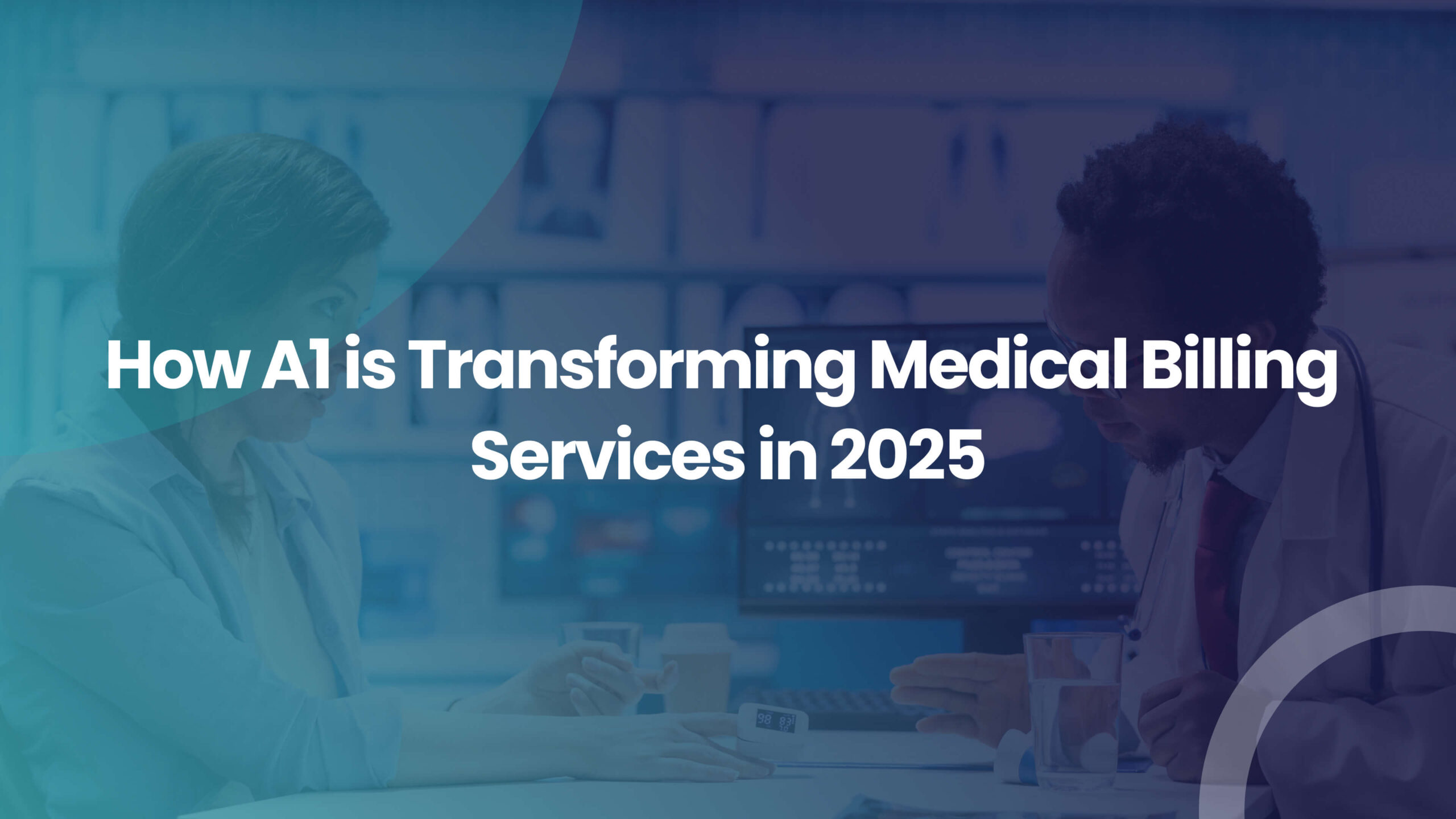Highlights
- AI medical billing market to reach $23 billion by 2031; 2025 is a turning point for healthcare revenue cycle management.
- GPT-4 and machine learning are automating 85% of routine billing tasks; reducing claim processing time from 14 days to 2–3 days.
- Healthcare organizations using AI billing solutions are seeing 15–20% revenue growth and 40–60% reduction in claim denials.
- New AI applications in 2025: real-time coding validation, predictive denial management, automated patient payment optimization.
- Human oversight remains essential for complex cases, regulatory compliance, and ethical AI implementation.
Medical billing is undergoing a transformation like never before in 2025 with artificial intelligence technologies changing how healthcare providers manage their revenue cycles. Administrative costs in U.S. healthcare have historically been 10–15% of total spend, so integration of AI into medical billing services is a big step towards operational efficiency and financial sustainability.
This goes way beyond simple task automation. Today’s AI systems can make intelligent decisions using predictive analytics and seamless EHR integration, changing how healthcare organizations approach billing and coding. From natural language processing that reads physician notes to machine learning that predicts claim denials, AI is redefining the revenue cycle.
The State of AI in Medical Billing: 2025
77% of healthcare providers are now using some form of automated billing technology, up from virtually none just five years ago. AI billing platforms have evolved into comprehensive systems integrated with EHRs, managing everything from patient documentation to final payment posting.
The shift from traditional billing workflows to AI-powered systems is driven by a shortage of skilled medical billers and coders, growing payer complexity, and financial pressures on providers. These intelligent systems handle both simple and complex billing tasks that previously required human expertise.
AI-driven revenue cycle management tools can process medical documentation, extract relevant details, and translate clinical notes into codes; a huge advantage for high-volume and complex healthcare environments.
AI Technologies Revolutionizing Medical Billing
1. Natural Language Processing and Advanced Coding
Natural language processing (NLP) is revolutionizing medical billing by reading physician notes, lab reports, and even handwritten documents to automatically extract clinical data and generate accurate medical codes.

AI-assisted coding tools now offer real-time ICD-11 and CPT code suggestions during documentation, ensuring compliance and optimizing reimbursements. These systems also reduce the documentation burden by 60%, freeing providers to focus on patient care.
- Cross-coding analysis: Machine learning identifies missed billable services and prevents revenue leakage.
- AI medical scribes: Automatically structure provider-patient conversations into billable data.
2. Predictive Analytics and Machine Learning
Machine learning algorithms now achieve 92% accuracy in predicting claim denial risks. They can flag problematic claims before submission, allowing proactive corrections that save time and cost.
- Revenue forecasting models: Analyze historical trends to optimize planning and cash flow.
- Patient payment behavior analysis: Predicts which patients are likely to pay on time for personalized billing strategies.
- Payer-specific rule engines: Adapt dynamically to evolving insurance rules, improving first-pass claim success.
3. Intelligent Automation and Robotic Process Automation (RPA)
While RPA automates repetitive workflows like eligibility verification and prior authorization, AI manages judgment-based billing tasks.
- Claims scrubbing: Detects potential issues pre-submission using contextual analysis.
- Automated appeals generation: AI creates precise documentation for claim denials, improving recovery success rates.
- Real-time payment posting: Matches payments with claims automatically, flagging discrepancies and fraud.
Measurable Benefits of AI in Medical Billing
Increased Accuracy and Quality
- 95% reduction in coding errors through AI validation systems.
- Real-time alerts ensure instant correction before claim submission.
- Comprehensive audit trails enhance transparency and regulatory compliance.
Operational Efficiency Gains
- 50–70% reduction in manual data entry and administrative workload.
- Claim processing time cut from 45 days to 25 days, improving cash flow by 30–40%.
- AI scalability enables 24/7 claim handling without proportional staffing increases.
Financial Performance Improvements
- 15% increase in collections through better charge capture and coding.
- Reduced A/R days lead to faster cash flow and stronger financial planning.
- Lower administrative costs and positive ROI within 40 days of deployment.
- AI analytics enhance payer contract negotiations through deeper insights.
2025 AI Applications Transforming Billing
Intelligent Patient Engagement and Billing
- AI chatbots: Provide 24/7 billing support and guide patients through payments.
- Personalized payment plans: Based on patient financial data to optimize collections.
- Automated cost estimations: Offer upfront billing transparency.
- Smart payment reminders: Use predictive timing for better collection rates.
Advanced Fraud Detection and Security
- AI detects fraudulent billing patterns in real-time with high accuracy.
- Anomaly detection prevents inappropriate coding before submission.
- HIPAA compliance ensured through encryption and access control.
- Blockchain integration enables secure, transparent billing transactions.
Comprehensive Revenue Cycle Optimization
- End-to-end workflow automation from scheduling to payment.
- Intelligent denial management with automated resolution strategies.
- Dynamic pricing optimization using market and payer data.
- Real-time analytics dashboards enable proactive financial management.
Implementation Challenges and Solutions
Technical and Integration Issues
- EHR compatibility and data standardization remain complex.
- Significant investment in staff training for AI-powered workflows.
- Upfront costs require careful budgeting and ROI planning.
- Data quality preparation is critical for effective AI performance.
Regulatory and Compliance
- Maintaining HIPAA compliance in AI-driven workflows is essential.
- Ongoing human oversight ensures systems adapt to regulatory changes.
- Explainable AI supports audit transparency and accountability.
Change Management and Workforce Adaptation
- Address staff concerns about automation and job shifts through communication.
- Develop new AI-era skills such as system management and data analysis.
- Design hybrid workflows blending AI efficiency with human judgment.
- Establish governance frameworks for AI oversight and auditing.
The Future of Human–AI Collaboration in Medical Billing
AI is redefining the roles of medical billers from data entry to AI supervision and optimization. Human expertise now focuses on managing complex billing cases, auditing AI outputs, and strategic revenue improvement.
New roles are emerging in AI training, validation, and optimization, combining billing knowledge with technical fluency. Hybrid workflows, AI for repetitive tasks, humans for nuanced judgment, are becoming the gold standard.
Continuous learning systems create feedback loops between humans and AI, improving performance and compliance over time.
2025 Industry Trends and Future Outlook
- Generative AI: Automating patient communication and appeals writing with a human tone.
- Telehealth Integration: Seamless billing for virtual care services.
- Voice-Activated Billing: Streamlined, hands-free documentation and coding.
- Predictive Modeling: Supporting value-based care and population health management.
- Industry Consolidation: Growth of AI-first billing service providers.
- 2026–2027 Outlook: Fully autonomous billing for routine cases, with humans overseeing complex exceptions.
Real-World Success Stories and Case Studies
- Bridge Billing Services: Reduced errors and improved cash flow through AI automation and oversight.
- Large Health System: Achieved ROI within 40 days and cut claim turnaround by 45%.
- Community Hospital: Lowered denial rate from 12% to 3% using predictive analytics.
- Specialty Practice: Increased revenue by $1.14M through AI-assisted coding accuracy.
- Multi-location Clinic: Enhanced patient satisfaction with automated communication and cost estimates.
Choosing the Right AI Billing Solution for Your Practice
- Ensure full EHR integration and compatibility.
- Prioritize vendors with specialty-specific AI experience.
- Evaluate vendor support, training, and post-deployment services.
- Plan realistic implementation timelines (typically 3–6 months).
- Define ROI metrics: claim turnaround, denial rate, collections, and staff productivity.
Questions to Ask Potential AI Billing Providers
- What experience do you have with our specific specialty or practice type?
- How does your system integrate with our existing EHR and billing software?
- What training and support are provided during implementation?
- How do you ensure HIPAA compliance and data security?
- What metrics do you use to measure success, and what results have clients achieved?
- How does your system handle complex billing scenarios requiring human judgment?
- What is the typical implementation timeline, and what support is offered?
FAQs
Q 1. Will AI replace human medical billers and coders in 2025?
Answer: No. While AI can automate up to 85% of routine billing tasks, human expertise is essential for complex cases, compliance, and quality control. The most effective model combines AI efficiency with human oversight.
Q 2. How long does implementation take?
Answer: Most AI implementations take 3–6 months, with initial results visible in 40 days and full ROI within 6–12 months.
Q 3. How is HIPAA compliance and data security maintained?
Answer: AI billing systems use end-to-end encryption, access controls, and audit trails. Choose providers certified with SOC 2 Type II and ensure Business Associate Agreements (BAAs) are in place.
Q 4. What are the upfront costs versus long-term savings?
Answer: Initial costs range from $50K to $500K depending on scale, but organizations typically achieve ROI in 40 days through 30–40% cost reduction and 15–20% revenue increase.
Q 5. How does AI handle complex billing scenarios requiring human review?
Answer: AI systems use confidence scoring to flag complex cases for human experts. Hybrid workflows ensure regulatory compliance and accuracy through a blend of automation and expert review.


